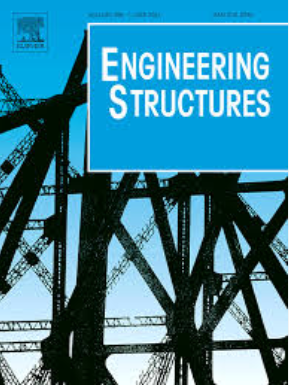Shear behavior of RC composite beams with HDC permanent formwork: Experimental study and PINN-based prediction
IF 6.4
1区 工程技术
Q1 ENGINEERING, CIVIL
引用次数: 0
Abstract
To realize the industrialization of construction and fill the gap in the shear performance research of reinforced concrete (RC) composite beams with high-ductility concrete (HDC) permanent formwork, this paper investigated the shear behaviors of ones. Eight beams, comprising one control beam and seven RC composite beams with HDC permanent formwork, underwent four-point flexural loading. The variable parameters were the type of formwork, space of the transverse bar, and shear-span ratio. The influences of these factors on the failure mode, load-deflection response, energy absorption capacity, and strain were discussed in this paper. The results indicated that the HDC permanent formwork can significantly enhanced the load-bearing capacity, ultimate deformation, and energy absorption capacity of the RC composite beams with HDC permanent formwork. Compared to the control beams, the improvements in load-bearing capacity, ultimate deflection, and energy absorption capacity are in the ranges of 2.1 %-15.3 %, 15.2 %-48.5 %, and 32.1 %-83.3 %, respectively. Installing carbon textile grids in the HDC permanent formwork can further enhance the load-bearing capacity and ultimate deformation of the RC composite beams with HDC permanent formwork. The effectiveness of the HDC permanent formwork to the shear-resistant capacity, deformability, and energy absorption capacity of the RC composite beams with HDC permanent formwork was more obvious at the high shear-to-span ratio and space of the transverse bar. Finally, based on the Guo et al. model, a Physics Informed Neural Network (PINN) model was set up, trained, verified, tested, and interpreted to predict the shear-resistance capacity of RC composite beams with HDC permanent formwork. The MSE, MAE, and R2 of the testing dataset were 193.24, 9.72, and 0.98, respectively. This proved that the established PINN model was more accurate and reliable.
HDC永久模板混凝土组合梁抗剪性能:试验研究及基于pnp的预测
为实现建筑产业化,填补高延性混凝土永久模板配筋混凝土组合梁抗剪性能研究的空白,对高延性混凝土永久模板配筋混凝土组合梁抗剪性能进行了研究。8根梁,包括1根控制梁和7根带有HDC永久模板的RC组合梁,进行了四点弯曲荷载。可变参数为模板类型、横杆间距和剪跨比。讨论了这些因素对破坏模式、荷载-挠曲响应、能量吸收能力和应变的影响。结果表明:HDC永久模板可显著提高混凝土组合梁的承载力、极限变形量和吸能能力;与对照梁相比,承载力、极限挠度和能量吸收能力的提高幅度分别为2.1 % ~ 15.3 %、15.2 % ~ 48.5 %和32.1 % ~ 83.3 %。在HDC永久模板中安装碳纤维网,可以进一步提高HDC永久模板RC组合梁的承载能力和极限变形量。HDC永久模板对采用HDC永久模板的RC组合梁抗剪能力、变形能力和吸能能力的影响在高剪跨比和高横杆间距时更为明显。最后,基于Guo等人的模型,建立了物理信息神经网络(PINN)模型,并进行了训练、验证、测试和解释,以预测HDC永久模板RC组合梁的抗剪能力。检验数据集的MSE、MAE和R2分别为193.24、9.72和0.98。这证明了所建立的PINN模型更加准确可靠。
本文章由计算机程序翻译,如有差异,请以英文原文为准。
求助全文
约1分钟内获得全文
求助全文
来源期刊

Engineering Structures
工程技术-工程:土木
CiteScore
10.20
自引率
14.50%
发文量
1385
审稿时长
67 days
期刊介绍:
Engineering Structures provides a forum for a broad blend of scientific and technical papers to reflect the evolving needs of the structural engineering and structural mechanics communities. Particularly welcome are contributions dealing with applications of structural engineering and mechanics principles in all areas of technology. The journal aspires to a broad and integrated coverage of the effects of dynamic loadings and of the modelling techniques whereby the structural response to these loadings may be computed.
The scope of Engineering Structures encompasses, but is not restricted to, the following areas: infrastructure engineering; earthquake engineering; structure-fluid-soil interaction; wind engineering; fire engineering; blast engineering; structural reliability/stability; life assessment/integrity; structural health monitoring; multi-hazard engineering; structural dynamics; optimization; expert systems; experimental modelling; performance-based design; multiscale analysis; value engineering.
Topics of interest include: tall buildings; innovative structures; environmentally responsive structures; bridges; stadiums; commercial and public buildings; transmission towers; television and telecommunication masts; foldable structures; cooling towers; plates and shells; suspension structures; protective structures; smart structures; nuclear reactors; dams; pressure vessels; pipelines; tunnels.
Engineering Structures also publishes review articles, short communications and discussions, book reviews, and a diary on international events related to any aspect of structural engineering.
 求助内容:
求助内容: 应助结果提醒方式:
应助结果提醒方式:


